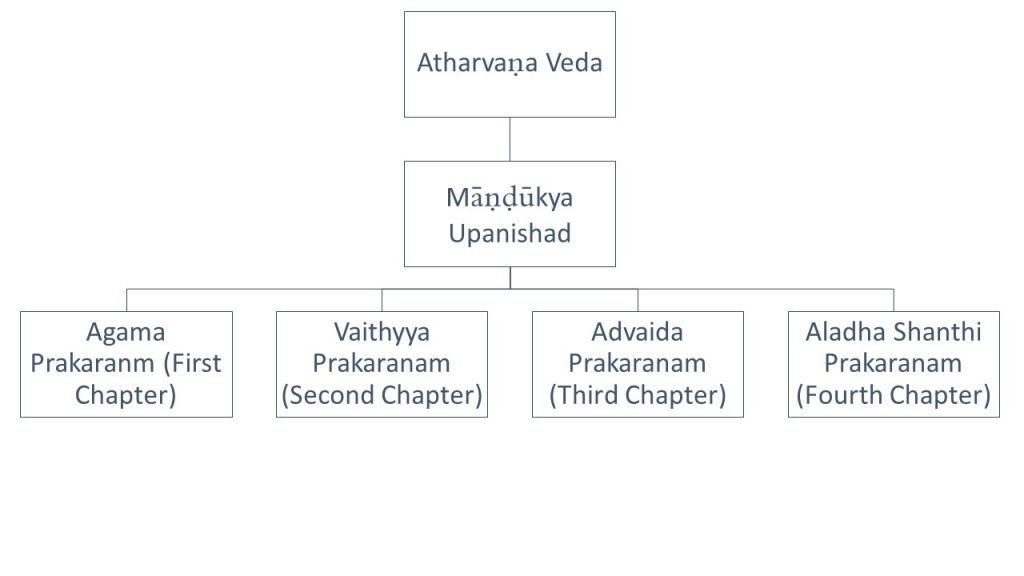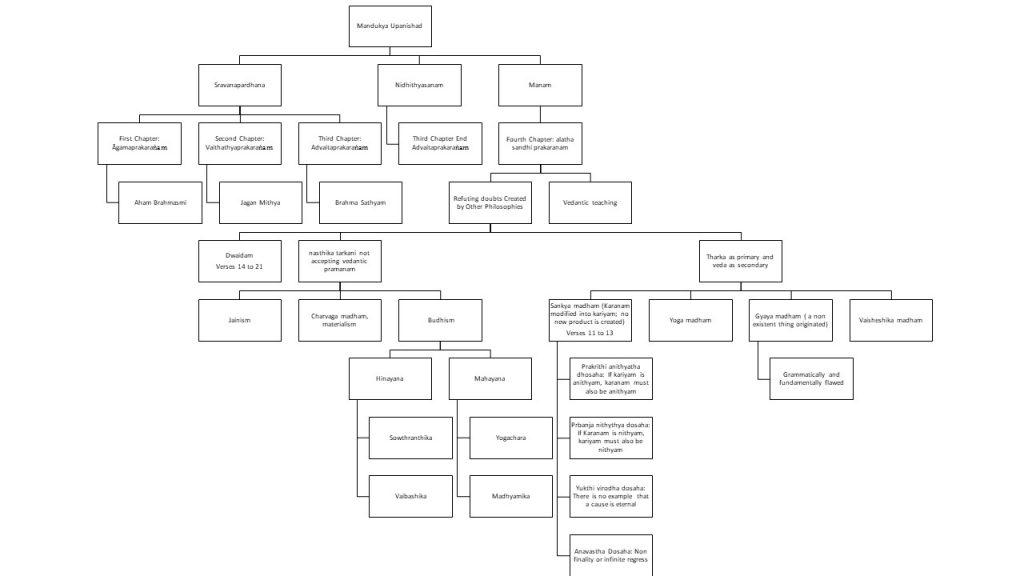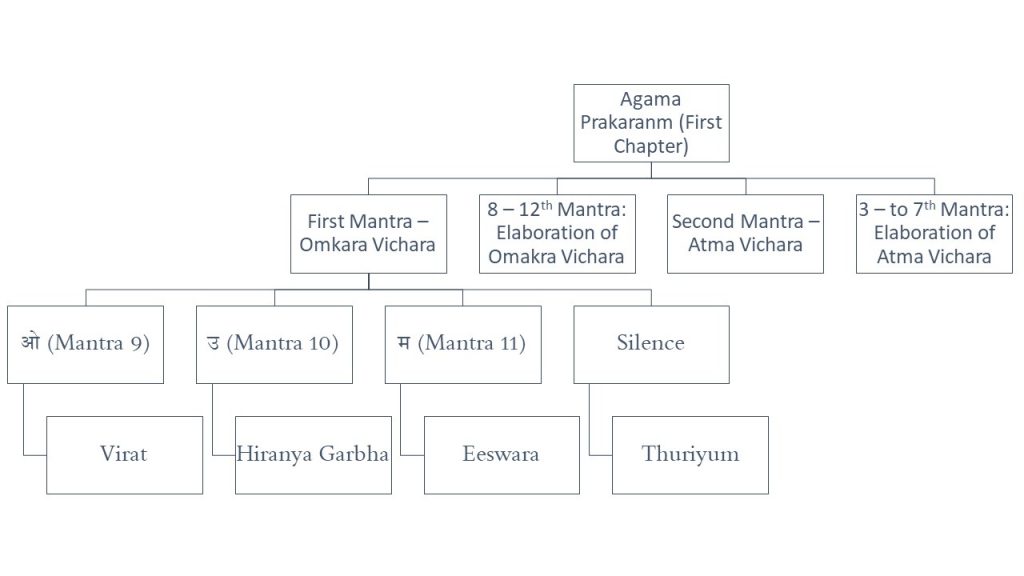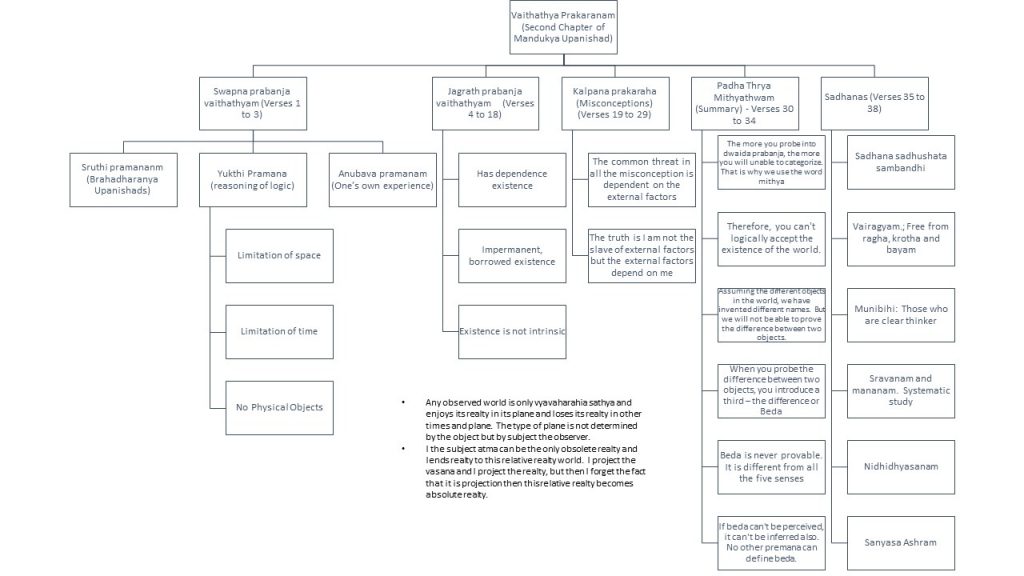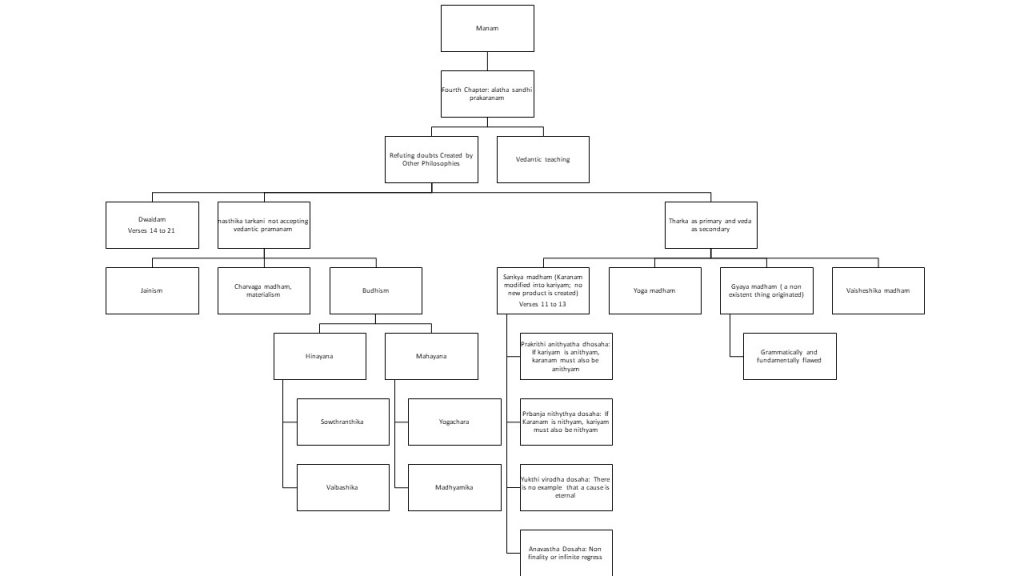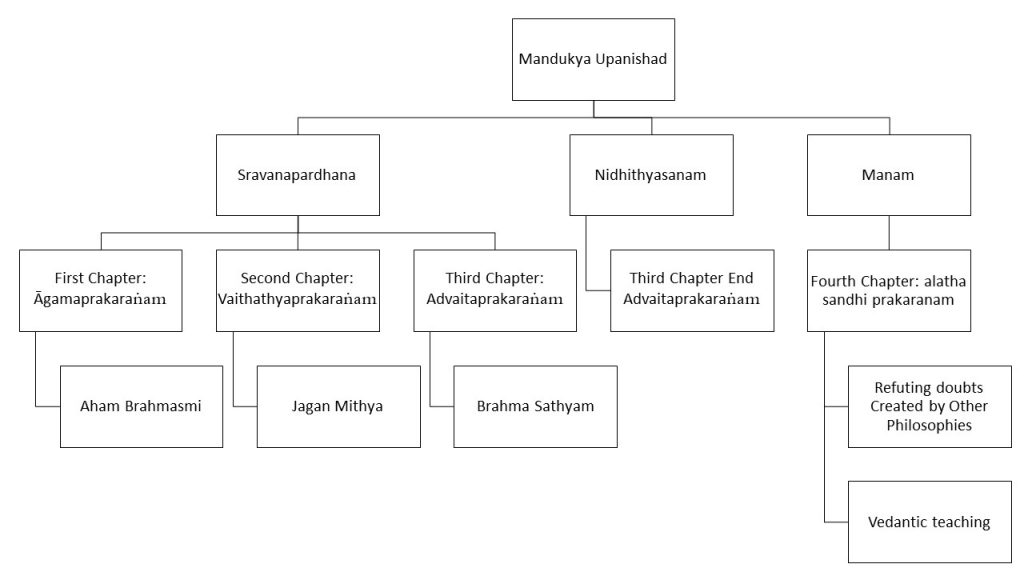16.2
Non-injury, truthfulness, absence of anger, renunciation, control of the
internal organ, absence of vilification, kindness to creatures,
non-covetousness, gentleness, modesty, freedom from restlessness;
Continuing his teachings Swamiji said, in the beginning of the 16th chapter, in the first three verses, Sri Krishna is giving a list of virtues which He names daivi sampath; and when a person lives a way of life; taking into account these virtues; then it will become conducive to atma Gyanam. We completed first verse in the last class and in the first verse, I had left out one word and I am happy that the students noted the omission and pointed it out to me. First, I will take up the omitted word, tapaha, in the second line.
If you split it; the word tapas or Tapaha has several meanings. Sri Krishna will talk about tapa elaborately in the 17th chapter, and He will divide tapas into three types, satvika, rajasika, and tamasika tapas. Here we will see one of the meanings of the word tapa; it is deliberately and willfully going through a painful experience for toughening one’s physical and mental personality. Voluntarily, deliberately going through some painful experience; of course, within a limit, in a controlled way; going through a painful experience, so that my body and mind will get toughened enough, immunized enough, to withstand pain or difficulty. So, immunization of the body, toughening of the body is the purpose of any form of tapas. And we have got many types of tapas, in the form of vrthams. For example, those who go Sabarimala, the Ayyappa temple in Kerala, they take a 41 day or 48 days of vow. And during these days; they willfully give up certain comforts. Certain types of physical comforts are given up, and the body is allowed to go through discomfort and similarly they walk 48 miles through thorns, stones and all those, without wearing a chappal; is a voluntary invitation of physical pain. Even though nowadays they can go through a very short route; they do that; Sometimes we can see people going to the Himalayan shrines of the Kedarnath and Badrinath, at higher altitudes, very cold; there also they go without proper cover, without chappal they go; this is a clear invitation to physical pain; but you do not call it suffering. A suffering is a suffering only when it is forced upon me by somebody else.
Whereas a suffering becomes a tapas when I myself, voluntarily, force on myself for the sake of toughening my body and mind. I have talked about this before; the difference between fasting and starving, is purely based on the attitude. When I want to eat food, and food is not available, it is starving; but food is available, but deliberately today happens to be Ekadasi and one stays away from food.
In Srirangam there are people who fast the whole day, even when food is available; I deliberately forgo and go through the pang and discomfort of hunger; and this voluntary suffering is called tapas. Shankaracharya calls it sharira pidanam; pidanam word he is using; but it is voluntary. The benefit, advantage of this tapas is the body gets a capacity to tolerate; tolerance of heat; tolerance of cold; tolerance of pain; so, increase of titiksha or tolerance is the benefit. And in Vedanta, tolerance is considered to be a very useful sadhana. It will help a person in several ways spiritually. One benefit is that if I toughen myself and develop tolerance when I have to go through choiceless pain. Everyone will have to face pain in life. Sometimes there are remedies, but there are occasions when a person is forced to go through pain and there is no cure or remedy. Like incurable disease or anything, I have got tolerance, choiceless pain in life will not disturb me too much. Thus, tolerance prepares myself to face choiceless pains in life; which is caused by prabhala prarabhada.
Durbhala prarabhda, gives me pain but I have remedy for weaker prarabhda, but there are prabhala prarabhda, which will give me pain for which I can have no remedy. How to face such choiceless pain? There is only one way; I have to raise my level of withstanding power; just as the military people develop that power; so, they have to learn to starve for days together; living with water; they have to survive with whatever they get; They have got endurance tests; thus, every human being requires increase in endurance power; And therefore, titiksha is useful to face choiceless situations.
The second benefit of tapas or increase of
tolerance is we can avoid impulsive reactions to situations. Any impulsive
reaction is because of lack of tolerance. I cannot tolerate nonsense. I cannot
tolerate adharmic action; I am extremely sensitive; many people say. When I am
sensitive and intolerant, the greatest disadvantage that I face, I impulsively
and immediately react to the situation without thinking. Any thoughtless action
is reaction; and any thoughtless reaction is improper; because we are not even
judging whether our actions are right or wrong. The only solution for impulsive
reaction is developing the tolerance power, so that even if somebody is doing
improper action, I can wait, analyze, think well and react at the proper time.
And when I react at proper time deliberately thoughtfully, it is no more a
reaction; it is an action. If I have to postpone my reaction, and deliberately
act, I require titiksha
or tolerance and that tolerance comes by practicing tapas. This is the second
benefit;
The third benefit of tolerance is this. Bhagavan has kept pain in life; not merely for hurting us. The role of pain is not merely wounding us, but Bhagavan wants to teach certain important lessons through pain also. So, sufferings also have a very important role in human life. And the important role of suffering is teaching; especially spiritual teaching; and if I should have the capacity to learn from suffering, I should enjoy an undisturbed mind. If suffering emotionally disturbs me, I will not be able to learn from suffering. I will go through sufferings but will continue to be where I am. So how can I learn from suffering? Only when my mind is calm, I can go through suffering and learn; and that is possible only when there is titiksha; there is tolerance. Therefore, the third benefit of tolerance is developing the faculty of learning from pain. Learning from suffering.
In fact, the very first chapter of the Gita is Arjuna vishada yoga. So Arjuna’s suffering taught a lot; At least he learned that he requires external help to solve the problem of raga, shoka and moha. And that is how he decided to surrender. Therefore, pain also has a role in spiritual growth; and I can make use of it only if I have tolerance. Thus, tapas plays a very important role in developing tolerance and therefore it is included in spiritual sadhana.
And now coming to the second verse, we saw the word Ahimsa, satyam, krodha and tyaga. The word tyaga, I pointed out, refers to renunciation; renunciation can be either external or internal. External renunciation is taking to a monastic life; internal renunciation is mentally dropping the ownership notion; I do not own anything. Bhagavan is the only owner; I am a trustee; I am supposed to only maintain things or maximize the use of things for the time being. This freedom from mamakara is called tyaga; mamakara tyaga.
The next value is shanti; shanti means the equanimity of mind; poise of mind; tranquility
of mind; freedom from stress and strain. Another word they use is anayasa;
inner relaxation. And this Shanti is a virtue, which we have to try to maintain
throughout the day, which Sri Krishna called samatvam yoga uchyate. The very karma yoga way of
life is to maintain this poise. And why is this shanti important? Only when the mind has shanti, intellect will be active and functional.
When the mind is disturbed, it will jam the intellect and it will not work. A Vedantic student has to do sravanam, mananam and nidhidhyasanam, all the three require an equanimous mind; therefore shanti. We can say, it is the samatvam attained through karma yoga. It is otherwise called samaha.
Then the next virtue is: Apaishunam. apaishunam means not publicizing the defects of other people. It is very enjoyable thing; it is a very juicy topic; to talk about the things happening in the neighborhood. Therefore, whatever defects are there; whatever deficiencies are there; whatever weaknesses are there, I enjoy talking about and whatever virtues are there; I carefully avoid. Shastra says it is never correct. If at all you want to talk about others, talk about their virtues. Cover up your virtues; publicize others’ virtues.
Therefore, he says apaishunam; never talk about the other people’s
weaknesses.
Then the next virtue is Daya bhuteshu. Daya means compassion, bhuta means all living beings; human beings, animals, towards all of them, have compassion, i.e. learn to look at their suffering by standing in their shoes. Temporarily imagine what will it be if I am in their position. So, then, certainly it will be impossible for us to injure others.
Therefore, bhuteshu daya, or bhuta daya is considered to be a very important virtue.
Then the next one is aloluptvam; aloluptvam means not yielding to the temptations of sense objects. So the world is full of maya. And the world is full of temptations, my sense organs can very easily become an addict to anything. So even when such temptations are there; not yielding to them, that self-control is called aloluptvam. Previously we saw the word dama; dama is in a general sense control; aloluptvam is specific sense control; when there are temptations.
Saying No to drugs; because there are certain
temptations like drug, liquor, cigarette, etc. We have to yield only once;
first time it is a deliberate mistake, and second time, that object becomes the
master and I become a slave. First, I am master, the cigarette is slave; second
time, the cigarette become stronger; then time, it will still become stronger;
after sometime, I am utterly helpless that I cannot even imagine giving it up.
You will find that once a person becomes an
addict, it is almost impossible to get out. You have to read the book of
Alcoholic Anonymous. They say God alone can help such an addict; For that, one
has to surrender to God. even that becomes difficult. And therefore, always say
No first.
Therefore, better not to go in front of it, at
all; and therefore aloluptvam.
Then the next one is mardavam; mardavam
means gentleness, in handling people, in handling things, gentleness or
politeness in manners; Not being rude is called mardavam.
The mind of the wise people is very unique. It has got two opposite virtues. One angle it is stronger and harder than even diamond; and from another angle they are tender; more tender than even flowers; How come one mind is both hard and tender. It is said when they are receiving experiences such as people insulting, people criticizing, people misbehaving; when they are facing adverse situations, their mind takes the mode of hardness; the mind is so strong that any adverse situation cannot affect it; like the rock of Gibraltar, it will not get affected; but the very same wise people when they are handling other people, when they are talking to other people, their language and behavior is more tender than even flowers. So, as a karta they have a tender mind; as a bhokta they have a diamond like hard mind. But the problem of the ignorant person is the other way around. He also has a hard and soft mind. When he faces situation, it is too soft; that at the slightest insult he is affected; When he handles people, it is so rock like and rude, neither he is happy nor the other people around are happy. So, gentleness in handling other people.
Then hrih means modesty, and also a sense of shame; a
healthy sense of shame. There are two types of shame, one is a healthy shame. A
healthy shame is defined as that, which obstruct a person from doing wrong
actions. Sometimes we feel ashamed to do certain things in front of others,
when that shame restrains us from doing adharmic actions, that sense of shame
is a worthy sense of shame and it has to be cultivated. Shamelessness in that
respect is an evil thing.
Therefore, healthy shame is called hrih or modesty.
Then the next virtue achapalam; chapalam means restlessness expressed at the body level. Restlessness which is primarily a mental condition and when the mind is highly restless, it overflows to the body level and through the body language, the person shows he is uncomfortable. Hands and legs are moving; face is twitching. He is biting the finger; first nails then finger. They eat pencils and pens; all kinds of things happen; fidgety character is called chapalam; where the body does lot of movements purposelessly. Moving the legs purposelessly, moving the hands purposelessly. All of them are called cheshtai. When we are children, parents used to tell us sit quietly without doing any cheshtai. That indriya cheshta is called chapalam; achapalam is freedom from that; body also is relaxed.
Shloka 16.3:
16.3
Vigor, forgiveness, fortitude, purity, freedom from malice, absence of
haughtiness-these, O scion of the Bharata dynasty, are (the alties) of one born
destined to have the divine nature.
Then next virtue is tejaha. teja means not being a victim of exploitation; goodness; Simplicity, it does not mean ideocracy. Being simple does not mean, being simpleton, it is not required; Be gentle; be good; be tolerant; all these virtues are very good; that does not mean that we should become door mats of other’s exploitation. If somebody is committing a mistake; if somebody is improperly behaving; it should not mean I should silently suffer and be a victim. I can certainly take appropriate action. I need not be taken for a ride in the name of being a Gita student. Do not cheat and do not get cheated.
It does not mean I should impulsively react
and get angry. It is not necessary, we can study the situation and first, then
we can use non-violent methods of handling and later, even if we have to take
violent steps; by all means take violent steps. If that is the ultimate necessary
evil.
So not victimizing one’s self is called tejaha; because just as we should not hurt others, we should not hurt ourselves also. We have a duty to our own body; our own mind; it does not mean I should unnecessarily suffer; it does not mean I have to put up with non-sense. Need not. So, a no-nonsense attitude is tejaha.
Then the next virtue is Kshama. Kshama is otherwise called Shanti in the 13th Chapter and it is called titiksha in the 2nd chapter.
And this word Kshama has several meanings; one meaning is tolerance, which we saw before; Kshama is the benefit gained through tapas. While explaining Tapas I said, by practicing tapas, a person will get forbearance or tolerance. This is one meaning.
But, Shankaracharya gives another meaning for the word Kshama by contrasting it with the word akrodha. Akrodha means capacity to handle anger. When the anger rises inside; before it is expressed outside, I allow that it to go through the filter of discrimination. Before expressing, if I can use my discrimination, discreet expression of anger; or discreet non-expression of anger; or discreet partial expression of anger; that is the management of anger. This was called akrodha in the second verse; Shankaracharya says kshama here means the mind becomes free from anger. Very tough; In the first stage, anger was allowed but it should be under your control; let it be but it should be within your control; but kshama means enjoying a mind in which anger does not rise at all. So non-arrival of anger is kshama; management of arrived-anger is akrodha. Is it possible for a person to avoid the rise of anger at all; looks it is almost impossible. In fact, even psychologists say anger is a healthy sign; healthy part of a regular mind; psychologists will not accept that; But Shankaracharya says it is possible. but he does not say how. We get a clue in the third chapter; we get the clue in the third chapter. There he defined anger is nothing but expectations converted to irritation; when it is obstructed; obstructed expectation gets converted to irritation. And since irritation is the converted form of expectation, if you have to handle irritation, you have to handle your expectation. Lesser the expectation, lesser the scope for anger; and even if expectations are unavoidable, try to make them into preferences.
And therefore, reduce the expectation and
whatever minimum you have, have non-binding expectation or we can call it preference.
That is the only way to avoid anger. There is no other remedy. Therefore, Kshama
is anger-lessness.
Dhrti means fortitude, perseverance, or will power
is called dhrti; the capacity to continue a sadhana in spite of obstacles, in
spite of hurdles, is called will power.
Sri Krishna will
talk about the importance of willpower in the 18th chapter; And there He will
talk about three types of willpower; satvic willpower; rajastic willpower and
tamasic willpower. I will not talk about it now; I hope you will have the
willpower to continue the classes until the 18Th. Therefore, dhrti; Dru means
holding on to. Dru, dharane; holding power; willpower.
Then the next
virtue is Shaucham. This also has come in the 13th chapter.
Shaucham is
cleanliness and orderliness. It should not stop with cleanliness only. We
should include orderliness, of the surroundings, from our street, visible from
the surroundings. We have the best teaching and least implementation; we have
got the best scriptures in the world; but we never implement. And the other countries;
they do not have such scriptures; and they seem to implement. We have the
enclosure for putting the rubbish; but it is put everywhere else, but in that particular
place. So, therefore, cleanliness of the surrounding; cleanliness of our dress;
cleanliness of the body. And above all, the toughest is the purity of the mind;
I have talked in
the 13th chapter, and therefore, I do not want to go to the details.
Then the next
virtue is Adroha; adroha is ahimsa at the mental level; not even desiring to
harm others; not even tending to harm others. So, they will not even think himsa.
Shankaracharya says, not only you should not hit others, even raising the hand saying that I will hit, not doing that is adroha; not even intending to harm others is called adrohaha;
Then the next one
is natimanita. This is amanitvam of the 13th chapter.
Freedom from
pride, freedom from superiority complex, or positively put, humility; humbleness
is called natimanita. This is supposed to be a very important virtue for a spiritual
student. Because, a spiritual student has to do the namaskara to the guru.
If I have got
arrogance, namaskara is the most difficult thing. And that too, namaskara to another human being is very difficult; and if a person does
not have that humility; knowledge will not flow down; because if
something has to flow down; it has to be from higher level to lower level. If the
knowledge should come; I should bend humbly. And therefore, natimanita means Humility;
All these virtues will be present
in a person who has got daivi sampath; who is born with daivi sampathi. So, one
who is born with satva guna, or one who is a satvic person, he or she will have all these virtues and if these
virtues are not there from birth; we have to cultivate them. Most of us do not
have them. Therefore, in Vedanta, cultivating these virtues alone will take more time. Vedantic study really does not take
time; maximum time is in getting this daivi sampath;
Shloka 16.4:
16.4
O son of Prtha, (the attributes) of one destined to have the demoniacal nature
are religious ostentation, pride and haughtiness, [Another reading is
abhimanah, self-conceit.-Tr.], anger as also rudeness and ignorance.
So having talked about the daivi sampath, that is the virtues belonging to a spiritually oriented person. Now Sri Krishna wants to talk about asuri sampath; which is naturally there; in a materialistic person. As I said asuri sampath does not mean a person who has got the protruding teeth like a demon, it is means one with materialistic tendencies. And what are they? Sri Krishna is going to enumerate them in this verse, He presents them in a nutshell and later, from the seventh verse, He will elaborate the very same asuri sampath, till verse No.21.
What is materialism? We get a very beautiful
list. What are they?
Dambhaha means
pomp and show; exhibitionism of their wealth; their position; their status etc.
which is also called ostentation;
Then the next materialistic tendency is darpaha. Along with money and power, comes arrogance. Disrespecting people, disrespecting elderly people etc.,
Therefore, darpaha means arrogance.
Then abhimana; superiority complex, looking upon oneself as puja yogya. One who deserve honor, reverence etc.
The difference between darpah and abimana is; darpaha is externally expressed arrogance; manitvam is unexpressed internally thought. One is at bhavana level another is at the karma or action level;
Then krodha; krodha is
anger; because there is power; because there is position; and therefore, he
does not mind ill-treating anyone; krodha means anger; rudeness, harshness,
impoliteness; mannerlessness; all are called krodha.
Then Agyanam, means ignorance and here the
word ignorance means ignorance of Dharma Shastra.
We are not talking about spiritual ignorance; because we are not dealing with
philosophy in these two chapters. Chpaters 16 and 17 are dealing ethics and
morality; And therefore, the word ignorance here means ignorance of ethics,
ignorance of morals; dharmadharma
aviveka.
These are all naturally there in a person who
is born with rajasic and tamasic tendencies. Especially if he belongs to a rich
family, then he may not know what is humility, and that becomes a very big obstacle.
Take Away:
Anger is
nothing but expectations converted to irritation; when it is obstructed;
obstructed expectation gets converted to irritation. And since irritation is
the converted form of expectation, if you have to handle irritation, you have
to handle your expectation. Lesser the expectation, lesser the scope for anger;
and even if expectations are unavoidable, try to make them into preferences.
With Best Wishes,
Ram Ramaswamy
